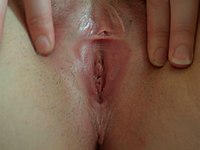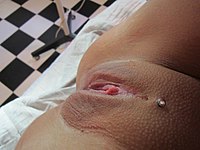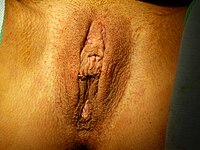Labiaplasty
| Labiaplasty | |
|---|---|
 Result of labiaplasty (top, left-before then right-after) in combination withclitoral hood reduction(bottom) |
Labiaplasty(also known aslabioplasty,labia minora reduction,andlabial reduction) is aplastic surgeryprocedure for creating or altering thelabia minora(inner labia) and thelabia majora(outer labia), the folds of skin of the humanvulva.It is a type ofvulvoplasty.There are two main categories of women seeking cosmetic genital surgery: those with conditions such asintersex,and those with no underlying condition who experience physical discomfort or wish to alter the appearance of their vulvas because they believe they do not fall within a normal range.[1]
The size, colour, and shape of labia vary significantly, and may change as a result of childbirth, aging, and other events.[1]Conditions addressed by labiaplasty includecongenital defectsandabnormalitiessuch asvaginal atresia(absent vaginal passage),Müllerian agenesis(malformed uterus and fallopian tubes), intersex conditions (male and female sexual characteristics in a person); and tearing and stretching of the labia minora caused by childbirth, accident, and age. In a male-to-femalesexual reassignmentvaginoplastyfor the creation of aneovagina,labiaplasty creates labia where once there were none.
A 2008 study reported that 32 percent of women who underwent the procedure did so to correct a functional impairment; 31 percent to correct a functional impairment and for aesthetic reasons; and 37 percent for aesthetic reasons alone.[2]According to a 2011 review, overall patient satisfaction is in the 90–95 percent range.[3]Risks include permanent scarring, infections, bleeding, irritation, and nerve damage leading to increased or decreased sensitivity. A change in requirements of publicly funded Australian plastic surgery requiring women to be told about natural variation in labias led to a 28% reduction in the number of surgeries performed.[4]Unlike public hospitals, cosmetic surgeons in private practice are not required to follow these rules, and critics say that "unscrupulous" providers are charging to perform the procedure on women who would not want it if they had more information.[4]
Images of vulvae are absent from the popular media[5][6]and advertising[7][8]: 19 and do not appear in some anatomy textbooks,[9]while community opposition tosex education[10][11]limits the access that young women have to information about natural variation in labias.[12]Many women have limited knowledge of vulval anatomy, and are unable to say what a "normal" vulva looks like.[13]: 6 [14][15][16]At the same time, manypornographicimages of women's genitals aredigitally manipulated,changing the size and shape of the labia to fit with the censorship standards in different countries.[12][17][18][19]Medical researchers have raised concerns about the procedure and its increasing prevalence rates, with some speculating that exposure to pornography images on the Internet may lead tobody imagedissatisfaction in some women.[20]Although it is also suggested that evidence for this is lacking,[20]theNational Health Servicestated that some women bring along advert or pornographic images to illustrate their desired genital appearance.[21][22]
Size of the labia

The externalgenitaliaof a woman are collectively known as the vulva. This comprises the labia majora (outer labia), the labia minora (inner labia), theclitoris,theurinary meatus,and thevaginal opening.The labia majora extend from themons pubisto theperineum.
The size, shape, and color of women's inner labia vary greatly.[23]One is usually larger than the other. They may be hidden by the outer labia, or may be visible, and may become larger with sexual arousal, sometimes two to three times their usual diameter.[24]
The size of the labia can change because of childbirth.Genital piercingscan increase labial size and asymmetry, because of the weight of the ornaments. In the course of treating identical twin sisters, S.P. Davisonet alreported that the labia were the same size in each woman, which indicatedgenetic determination.[25]In or around 2004, researchers from the Department of Gynaeology, Elizabeth Garret Anderson Hospital, London, measured the labia of 50 women between the ages of 18 and 50, with a mean age of 35.6:[1]
| Measurements | Mean[standard deviation] | |
|---|---|---|
| Clitorallength (mm) | 5.0 – 35.0 | 19.1 [8.7] |
| Clitoral glanswidth (mm) | 3.0 – 10.0 | 5.5 [1.7] |
| Clitoris tourethra(mm) | 16.0 – 45.0 | 28.5 [7.1] |
| Labia majoralength (cm) | 7.0 – 12.0 | 9.3 [1.3] |
| Labia minoralength (mm) | 20 – 100 | 60.6 [17.2] |
| Labia minora width (mm) | 7.0 – 50.0 | 21.8 [9.4] |
| Perineumlength (mm) | 15.0 – 55.0 | 31.3 [8.5] |
| Vaginallength (cm) | 6.5 – 12.5 | 9.6 [1.5] |
| Tanner Stage(n) | IV | 4.0 (8%) |
| V | 46 (92%) | |
| Color of the genital area compared to the surrounding skin (n) |
Same color | 9 (18%) |
| Darker color | 41 (82%) | |
| Rugosityof the labia (n) | Smooth (unwrinkled) | 14 (28%) |
| Moderately wrinkled | 34 (68%) | |
| Markedly wrinkled | 2 (4%) |
Surgery
Contraindications
Labia reduction surgery is relatively contraindicated for the woman who have active gynecological disease, such as an infection or amalignancy;the woman who is atobacco smokerand is unwilling to quit, either temporarily or permanently, in order to optimize her wound-healing capability; and the woman who is unrealistic in her aesthetic goals. The latter should either be counselled or excluded from labioplastic surgery. Davisonet alwrite that it should not be performed when the patient is menstruating to reduce potential hormonal effects and the increased risk of infection.[25]
Sex reassignment surgery
Insexual reassignmentsurgery, in the case of the male-to-femaletransgenderpatient, labiaplasty is usually the second stage of a two-stage vaginoplasty/vulvoplastyoperation, where labiaplastic techniques are applied to create labia minora and a clitoral hood. In this procedure, the labiaplasty is usually performed some months after the first stage of vaginoplasty.
Anaesthesia
Labial reduction can be performed underlocal anaesthesia,conscious sedation,orgeneral anaesthesia,either as a discrete, single surgery, or in conjunction with another,gynecologicor cosmetic, surgery procedure.[26]The resection proper is facilitated with the administration of an anaesthetic solution (lidocaine + epinephrine in saline solution) that is infiltrated to the labia minora to achieve the tumescence (swelling) of the tissues and the constriction of the pertinent labial circulatory system, the hemostasis that limits bleeding.[25]
Procedures
Edge resection technique
The original labiaplasty technique was simple resection of tissues at the free edge of the labia minora. One resection-technique variation features a clamp placed across the area of labial tissue to be resected, in order to establish hemostatis (stopped blood-flow), and the surgeon resects the tissues, and then sutures the cut labium minus or labia minora. This procedure is used by most surgeons because it is easiest to perform. The technical disadvantages of the labial-edge resection technique are the loss of the natural rugosity (wrinkles) of the labia minora free edges, thus, aesthetically, it produces an unnatural appearance to the vulva, and also presents a greater risk of damaging the pertinent nerve endings. Moreover, there also exists the possibility of everting (turning outwards) the inner lining of the labia, which then makes visible the normally hidden internal, pink labial tissues. The advantages of edge-resection include removal of the hyper-pigmented (darkened) irregular labial edges with a linear scar. Another disadvantage of the trim or "amputation" method, is that it is unable to excise redundant tissues of the clitoral hood, when present.[27][28][29][30][31][32]Complete amputation of the labia minora is more common with this technique, which often requires additional surgery to correct. In addition, the trim method does not address the clitoral hood. Clitoral hood deformities are common with this approach, again requiring additional corrective surgery. Some women complain of a "small penis" when the trim procedure is performed, owing to the un-addressed clitoral hood tissue and completely removed (amputated) labia minor.[33]Most plastic surgeons do not perform this procedure, and instead favor the extended wedge approach, which is technically more demanding, but produces a more natural result and is able to create a natural and proportioned appearance to the vulva.[34]Reconstructive procedures are often required after the trim (amputation) labiaplasty.[35]
Central wedge resection technique
Labial reduction by means of a central wedge-resection involves cutting and removing a partial-thickness wedge of tissue from the thickest portion of the labium minus.[28]Unlike the edge-resection technique, the resection pattern of the central wedge technique preserves the natural rugosity ( "wrinkled" edge) of the labia minora. If performed as a full-thickness resection, there exists the potential risk of damaging the pertinent labial nerves, which can result in painfulneuromas,and numbness. A partial thickness removal of mucosa and skin, leaving the submucosa intact, decreases the risk of this complication. F. Giraldoet al.procedurally refined the central wedge resection technique with an additional 90-degreeZ-plastytechnique, which produces a refined surgical scar that is less tethered, and diminishes the physical tensions exerted upon the surgical-incision wound, and, therefore, reduces the likelihood of a notched (scalloped-edge) scar.[28][36]The central wedge-resection technique is a demanding surgical procedure, and difficulty can arise with judging the correct amount of labial skin to resect, which might result in either undercorrection (persistent tissue-redundancy), or the overcorrection (excessive tension to the surgical wound), and an increased probability ofsurgical-wound separation.The benefit of this technique is that an extended wedge can be brought upwards towards the prepuce to treat a prominent clitoral hood without a separate incision.[35]This leads to a natural contour for the finished result, and avoids direct incisions near the highly-sensitive clitoris.
De-epithelialization technique
Labial reduction by means of the de-epithelialization of the tissues involves cutting theepitheliumof a central area on the medial and lateral aspects of each labium minus (small lip), either with a scalpel or with amedical laser.This labiaplasty technique reduces the vertical excess tissue, whilst preserving the natural rugosity (corrugated free-edge) of the labia minora, and thus preserves the sensory and erectile characteristics of the labia. Yet, the technical disadvantage of de-epithelialization is that the width of the individual labium might increase if a large area of labial tissue must be de-epithelialized to achieve the labial reduction.[37]
Labiaplasty with clitoral unhooding
Labial reduction occasionally includes the resection of theclitoral hoodwhen the thickness of its skin interferes with the woman'ssexual responseor is aesthetically displeasing.[33][34]
The surgical unhooding of the clitoris involves a V–to–Y advancement of the soft tissues, which is achieved bysuturingthe clitoral hood to the pubic bone in the midline (to avoid thepudendal nerves); thus, uncovering the clitoris further tightens the labia minora.[35]
Laser labiaplasty technique
Labial reduction by means oflaserresection of the labia minora involves the de-epithelialization of the labia. The technical disadvantage of laser labiaplasty is that the removal of excess labialepidermisrisks causing the occurrence ofepidermal inclusion cysts.[38]
Labiaplasty by de-epithelialization
Labial reduction by de-epithelialization cuts and removes the unwanted tissue and preserves the natural rugosity (wrinkled free-edge) of thelabia minora,and preserves the capabilities fortumescenceandsensation.Yet, when the patient presents with much labial tissue, a combination procedure of de-epithelialization and clamp-resection is usually more effective for achieving the aesthetic outcome established by the patient and her surgeon. In the case of a woman with labial webbing (redundant folding) between the labia minora and the labia majora, the de-epithelialization labiaplasty includes an additional resection technique – such as the five-flap Z-plasty ( "jumping man plasty" ) – to establish a regular and symmetric shape for the reduced labia minora.[25]
Post-operative care
Post-operative pain is minimal, and the woman is usually able to leave hospital the same day. No vaginal packing is required, although she might choose to wear a sanitary pad for comfort. The physician informs the woman that the reduced labia are often very swollen during the early post-operative period, because of theedemacaused by the anaesthetic solution injected to swell the tissues.
She is also instructed on the proper cleansing of the surgical wound site, and the application of a topical antibiotic ointment to the reduced labia, a regimen observed two to three times daily for several days after surgery.[25]
The woman's initial, post-labiaplasty follow up appointment with the surgeon is recommended within the week after surgery. She is advised to return to the surgeon's consultation room should she develophematoma,an accumulation of blood outside the pertinent (venousandarterial) vascular system. Depending on her progress, the woman can resume physically unstrenuous work three to four days after surgery. To allow the wounds to heal, she is instructed not to use tampons, not to wear tight clothes (e.g. thong underwear), and to abstain from sexual intercourse for four weeks after surgery.[25]
Medical complications to a labiaplasty procedure are uncommon, yet occasional complications – bleeding,infection,labial asymmetry,poor wound-healing, undercorrection, overcorrection – do occur, and might require a revision surgery. An over-aggressive resection might damage the nerves, causing painfulneuromas.Performing a flap-technique labiaplasty occasionally presents a greater risk fornecrosisof the labia minora tissues.[25]
Criticism

Labiaplasty is a controversial subject. Critics argue that a woman's decision to undergo the procedure stems from an unhealthy self-image induced by their comparison of themselves to the prepubescent-like images of women they see in commercials or pornography.[39]
In Australia, theRoyal Australian College of General Practitionershas issued guidelines on referring patients with dissatisfaction with their genitals to specialists.[13]A change in requirements of publicly funded Australianplastic surgeryrequiring women to be told about natural variation in labias led to a 28% reduction in the numbers of surgeries performed.[4]Unlike public hospitals, cosmetic surgeons in private practise are not required to follow these rules, and critics say that "unscrupulous" providers are charging to perform the procedure on women who would not undergo it if they had more information.[4]
Increasing numbers of women in Western countries are also usingBrazilian waxingto remove pubic hair, and choosing to wear tight-fitting swimwear and clothing.[13][40]This has led to increased numbers of women complaining of pain and discomfort from chafing of thelabia minora,as well as cosmetic concerns around how the appearance of genitals.[13][41][42]In many countries, media regulation classifies "hardcore" and "softcore" pornography – demanding that magazines with "hardcore" pornography be wrapped in black plastic and sold only to people over 18 who show photo ID.[17][43]Sales of magazines in black plastic tend to be low, and thus many magazine publishers choose to comply with the "softcore" standards.[17]In Australian magazines, images of vulvas that do not look like "a single crease" are digitally modified to comply with the censorship standard.[17]An Australian pornographic actress says that images of her own genitals sold to pornographic magazines in different countries aredigitally manipulatedto change the size and shape of the labia according to censorship standards in different countries.[12][18][19]Community opposition tosex education[10][11]limits the access that young women have to information about natural variation in labias.[12]
Linda Cardozo,a gynaecologist atKing's College Hospital,London, told the newspaper that women were placing themselves at risk in an industry that is largely unregulated.Nina Hartleysays that "she’s seen every type of vulva in her three decades working in the industry. When young women start out in porn, producers don’t send them off for a routine labiaplasty."[44]
Althoughfemale genital mutilation– the practice of cutting off a woman's labia and sometimes clitoris, and in some cases creating a seal across her entire vulva – is illegal across the Western world, Simone Davis, a professor and gender theorist at Mount Holyoke College in Massachusetts, argues that "when you really look carefully at the language used in some of those laws, they would also make illegal the labiaplasties that are being done by plastic surgeons in the U.S."[45]TheWorld Health Organization(WHO) defines female genital mutilation as "all procedures that involve partial or total removal of the external female genitalia, or other injury to the female genital organs for non-medical reasons."[46]The WHO writes that the term is not generally applied to elective procedures such as labiaplasty.[47]
TheAmerican College of Obstetricians and Gynecologists(ACOG) published an opinion in the September 2007 issue ofObstetrics & Gynecologythat several "vaginal rejuvenation" procedures were not medically indicated, and that there was no documentation of their safety and effectiveness. ACOG argued that it was deceptive to give the impression that the procedures were accepted and routine surgical practices. It recommended that women seeking such surgeries must be given the available surgical-safety statistics, and warned of the potential risks of infection, altered sensation caused by damaged nerves,dyspareunia(painful sexual intercourse),tissue adhesions,and painful scarring.[48]
In the UK, Lih Mei Liao and Sarah M. Creighton of the University College London Institute for Women's Health wrote in theBritish Medical Journalin 2007 that "the few reports that exist on patients' satisfaction with labial reductions are generally positive, but assessments are short-term and lack methodological rigour." They wrote that the increased demand for cosmetic genitoplasty (labiaplasty) may reflect a "narrow social definition of normal." TheNational Health Serviceperformed double the number of genitoplasty procedures in the year 2006 than in the 2001–2005 period. The authors noted that "the patients consistently wanted their vulvas to be flat, with no protrusion beyond the labia majora... some women brought along images to illustrate the desired appearance, usually from adverts or pornography that may have been digitally altered."[21][22]The Royal Australian and New Zealand College of Obstetricians and Gynæcologists published the same concern about the exploitation of psychologically insecure women.[45]
The International Society for the Study of Women's Sexual Medicine produced a report in 2007 concluding that "vulvar plastic surgery may be warranted only after counseling if it is still the patient's preference, provided that it is conducted in a safe manner and not solely for the purpose of performing surgery".[49]
See also
References
Notes
- ^abcLloyd, Jillian; Crouch, Naomi S.; Minto, Catherine L.; Liao, Lih-Mei; Creighton, Sarah M. (May 2005). "Female genital appearance:" normality "unfolds".BJOG: An International Journal of Obstetrics & Gynaecology.112(5): 643–646.CiteSeerX10.1.1.585.1427.doi:10.1111/j.1471-0528.2004.00517.x.PMID15842291.S2CID17818072.Pdf.
- ^Miklos, John R.; Moore, Robert D. (June 2008). "Labiaplasty of the labia minora: patients' indications for pursuing surgery".Journal of Sexual Medicine.5(6): 1492–1495.CiteSeerX10.1.1.486.7970.doi:10.1111/j.1743-6109.2008.00813.x.PMID18355172.
- ^Goodman, Michael P. (June 2011). "Female genital cosmetic and plastic surgery: a review".Journal of Sexual Medicine.8(6): 1813–1825.doi:10.1111/j.1743-6109.2011.02254.x.PMID21492397.
- ^abcd"Women being 'upsold' into labiaplasty by cosmetic clinics, say health experts".The Sydney Morning Herald.29 August 2015.
- ^"Honi Soit publishes vagina cover".Daily Life.Archived fromthe originalon 23 March 2019.Retrieved30 August2015.
- ^"That's my vagina on honi soit (NSFW)".BIRDEE.10 July 2017. Archived fromthe originalon 2 March 2016.Retrieved30 August2015.
- ^Liao, L-M; Michala, L; Creighton, SM (January 2010)."Labial surgery for well women: a review of the literature".BJOG: An International Journal of Obstetrics & Gynaecology.117(1): 20–25.doi:10.1111/j.1471-0528.2009.02426.x.PMID19906048.S2CID45078961.
- ^"Women and Genital Cosmetic Surgery"(PDF).Women's Health Issues Paper.Women's Health Victoria. February 2013.ISSN1837-4417.Archived fromthe original(PDF)on 12 March 2018.Retrieved30 August2015.
- ^Andrikopoulou, M.; Michala, L.; Creighton, S.M.; Liao, L-M. (October 2013). "The normal vulva in medical textbooks".Journal of Obstetrics & Gynaecology.33(7): 648–650.doi:10.3109/01443615.2013.807782.PMID24127945.S2CID20545099.
- ^abGilbert Herdt (1 June 2009).Moral panics, sex panics: fear and the fight over sexual rights.NYU Press.ISBN978-0-8147-3723-1.
- ^abIrvine, Janice M. (September 2006). "Emotional scripts of sex panics".Sexuality Research and Social Policy.3(3): 82–94.doi:10.1525/srsp.2006.3.3.82.S2CID144221306.
- ^abcdMarriner, Katy (2013).The Vagina Diaries - a study guide(PDF).Australian Teachers of Media - ATOM.ISBN978-1-74295-374-8.
{{cite book}}:|work=ignored (help)[permanent dead link] - ^abcd"Female genital cosmetic surgery: A resource for general practitioners and other health professionals"(PDF).Royal Australian College of General Practitioners.July 2015. Archived fromthe original(PDF)on 24 September 2015.Retrieved30 August2015.
- ^Schober, Justine M.; Alguacil, Nieves Martin; Cooper, R. Scott; Pfaff, Donald W.; Meyer-Bahlburg, Heino F.L. (April 2015). "Self-assessment of anatomy, sexual sensitivity, and function of the labia and vagina".Clinical Anatomy.28(3): 355–362.doi:10.1002/ca.22503.PMID25683213.S2CID2202201.
- ^Schober, Justine M.; Meyer-Bahlburg, Heino F.L.; Ransley, Philip G. (September 2004)."Self-assessment of genital anatomy, sexual sensitivity and function in women: implications for genitoplasty".BJU International.94(4): 589–94.doi:10.1111/j.1464-410X.2004.05006.x.PMID15329118.S2CID24224064.
- ^Howarth, Calida."Neat, discreet and unseen – young women's views on vulval anatomy"(PDF).
- ^abcdThe Labiaplasty Fad? - Sex.Hungry Beast.Australian Broadcasting Corporation.15 April 2010.Archivedfrom the original on 21 December 2021.
- ^ab"Labiaplasty and Censorship - is there a link?".Mamamia.25 November 2010.
- ^ab"Blame it on the Brazilian".BIRDEE.10 July 2017. Archived fromthe originalon 4 March 2016.Retrieved30 August2015.
- ^abDavis, Rowenna (27 February 2011)."Labiaplasty surgery increase blamed on pornography".The Observer.Guardian Media Group.
- See also:Navarro, Mireya (28 November 2004)."The most private of makeovers".The New York Times.
- ^abLiao, Lih Mei; Creighton, Sarah M. (26 May 2007)."Requests for cosmetic genitoplasty: how should healthcare providers respond?".The British Medical Journal.334(7603): 1090–1092.doi:10.1136/bmj.39206.422269.BE.PMC1877941.PMID17525451.
- ^abBanyard K (2010).The Equality Illusion: The Truth about Women and Men Today.Faber & Faber.p.41.ISBN978-0571258666.
- ^Masters, William H.; Johnson, Virginia E.; and Kolodny, Robert C.Human sexuality.HarperCollins College Publishers, 1995, p. 47.
- ^Sloane, Ethel.Biology of women.Cengage Learning, 2002,p. 32.
- ^abcdefgDavison S.P.et al."Labiaplasty and Labia Minora Reduction",eMedicine.com, 23 June 2008.
- ^Nevárez Bernal, Roberto Armando; Meráz Ávila, Diego (June 2009). "Fusion of the labia minora as a cause of urinary incontinence in a postmenopausal woman: a case report and literature review".Ginecología y Obstetricia de México.77(6): 287–290.PMID19681370.Original pdf of article (Spanish).
- ^Hodgkinson, Darryl J.; Hait, Glen (September 1984). "Aesthetic Vaginal Labioplasty".Plastic and Reconstructive Surgery.74(3): 414–6.doi:10.1097/00006534-198409000-00015.PMID6473559.S2CID43862052.
- ^abcAlter, Gary J. (March 1998). "A new technique for aesthetic labia minora reduction".Annals of Plastic Surgery.40(3): 287–290.doi:10.1097/00000637-199803000-00016.PMID9523614.
- ^Alter, Gary J. (June 2005). "Letters and viewpoints: Central wedge nymphectomy with a 90-degree Z-plasty for aesthetic reduction of the labia minora".Plastic and Reconstructive Surgery.115(7): 2144–2145.doi:10.1097/01.PRS.0000165466.99359.9E.PMID15923876.
- ^Rouzier, Roman; Louis-Sylvestre, Christine; Paniel, Bernard-Jean; Haddad, Bassam (January 2000). "Hypertrophy of labia minora: experience with 163 reductions".American Journal of Obstetrics and Gynecology.182(1 Pt 1): 35–40.doi:10.1016/S0002-9378(00)70488-1.PMID10649154.
- ^Alter, Gary J. (July 2007)."Aesthetic labia minora reduction with inferior wedge resection and superior pedicle flap reconstruction".Plastic and Reconstructive Surgery.120(1): 358–9, author reply 359–60.doi:10.1097/01.prs.0000264588.97000.dd.PMID17572600.
- ^Maas, Sylvester M.; Hage, J. Joris (2000). "Functional and aesthetic labia minora reduction".Plastic & Reconstructive Surgery.105(4): 1453–6.doi:10.1097/00006534-200004040-00030.PMID10744241.
- ^abHamori, Christine A. (1 September 2013)."Postoperative clitoral hood deformity after labiaplasty".Aesthetic Surgery Journal.33(7): 1030–1036.doi:10.1177/1090820X13502202.PMID24005612.
- ^abHunter, John G. (1 September 2013)."Commentary on: postoperative clitoral hood deformity after labiaplasty".Aesthetic Surgery Journal.33(7): 1037–1038.doi:10.1177/1090820X13503476.PMID24081697.
- ^abcAlter, Gary J. (December 2008). "Aesthetic labia minora and clitoral hood reduction using extended central wedge resection".Plastic and Reconstructive Surgery.122(6): 1780–1789.doi:10.1097/PRS.0b013e31818a9b25.PMID19050531.S2CID39680737.
- ^Giraldo, Francisco; González, Carlos; de Haro, Fabiola (May 2004). "Central wedge nymphectomy with a 90-degree Z-plasty for aesthetic reduction of the labia minora".Plastic and Reconstructive Surgery.113(6): 1820–1825, discussion 1826–1827.doi:10.1097/01.PRS.0000117304.81182.96.PMID15114151.S2CID31285182.
- ^Choi, Hee Youn; Kim, Kyung Tai (January 2000). "A new method for aesthetic reduction of labia minora (the deepithelialized reduction labioplasty)".Plastic & Reconstructive Surgery.105(1): 419–422, discussion 423–424.doi:10.1097/00006534-200001000-00070.PMID10627011.S2CID20089801.
- ^Pardo, J.; Solà, V.; Ricci, P.; Guilloff, E. (April 2006). "Laser labioplasty of labia minora".International Journal of Gynaecology and Obstetrics.93(1): 38–43.doi:10.1016/j.ijgo.2006.01.002.PMID16530764.S2CID35056032.
- ^Veale, D. and Neziroglu, F.Body Dysmorphic Disorder: A Treatment Manual.John Wiley and Sons, 2010,p. 104.
- ^"Labiaplasty surgery on the rise in Australia but a backlash looms".Daily Life.Archived fromthe originalon 17 October 2016.Retrieved30 August2015.
- ^Cornwall, Deborah (10 October 2014)."Designer vaginas: Pubic hair removal leading to increased requests for labiaplasties, doctors warn".ABC News.
- ^"The rise of labiaplasty".The Glow.26 December 2015.
- ^Mia Freedman(30 November 2009)."Genital surgery. Two words you don't want to read in the same sentence".Mamamia.
- ^Hess, Amanda."Insecure About Your Vagina?",Slate,20 February 2013.
- ^abCormier, Zoe (Fall 2005)."Making the cut".Shameless.Archived fromthe originalon 3 October 2011.
- Davis, Simone Weil (Spring 2002). "Loose lips sink ships".Feminist Studies.28(1): 7–35.doi:10.2307/3178492.JSTOR3178492.
- ^"Female genital mutilation",World Health Organization, February 2010.
- ^"Eliminating Female Genital Mutilation",World Health Organization, 2008.
- For a discussion of elective procedures and their relationship to FGM, see Annex 2, p. 24.
- ^ACOG Office of Communications (1 September 2007)."ACOG press release: ACOG advises against cosmetic vaginal procedures due to lack of safety and efficacy data".acog.org.American College of Obstetricians and Gynecologists.Archived fromthe originalon 21 October 2011.
- Committee on Gynecologic Practice (September 2007)."Vaginal" rejuvenation "and cosmetic vaginal procedures".ACOG Committee Opinion.110(3): 737–738.doi:10.1097/01.aog.0000263927.82639.9b.PMID17766626.Pdf.
- ^Goodman, Michael P.; et al. (March 2007)."Is elective vulvar plastic surgery ever warranted, and what screening should be conducted preoperatively?".Journal of Sexual Medicine.4(2): 269–276.doi:10.1111/j.1743-6109.2007.00431.x.hdl:2027.42/72245.PMID17367421.Archived fromthe originalon 29 February 2016.
Further reading
- Boston Women’s Health Book Collective (2011).Our bodies, ourselves.New York: Simon & Schuster.ISBN9781439190661.Preview.
- Revill, Jo (17 August 2003)."The new nose job: designer vaginas".The Observer.Guardian Media Group.
- Rogers, Lisa(15 August 2008)."The quest for the perfect vagina".The Guardian.
- Lisa Rogers(writer and presenter) (17 August 2008).The Perfect Vagina(TV programme). The G-spot series. London:North One Television.Archived fromthe originalon 16 May 2011.Retrieved18 September2011– viaChannel 4.
- Jones, Bethany; Nurka, Camille (January 2015). "Labiaplasty and pornography: a preliminary investigation".Porn Studies.2(1): 62–75.doi:10.1080/23268743.2014.984940.hdl:1885/23945.S2CID71790662.
External links
![]() Media related toLabiaplastyat Wikimedia Commons
Media related toLabiaplastyat Wikimedia Commons






